French Expeditions to Ireland 1796 - 1798
Expedition of 1796
As part of the First Coalition united against the French Republic and its ideals, the government of Great Britain continued to fund the Coalition powers and their campaigns against France. Furthermore, Great Britain continued to aid French royalists seeking to destroy the republic, and the British had more recently supported the French rebels in the Vendée. French General Hoche, who had successfully pacified the royalist rebellion in the Vendée in 1795, dreamt of leading an expedition to British shores as payback. But instead of attacking England directly, Hoche was convinced by Irish patriots in France that a more suitable target would be Ireland. Irish soldiers had served faithfully in French regiments for more than a hundred years and Ireland was ripe for revolt due to oppressive religious and taxation laws. The hope was that if the French could land a force in Ireland, then Great Britain would be forced onto the defensive, Irish forces would rise up in revolt, and a sister republic to the French Republic could be established.
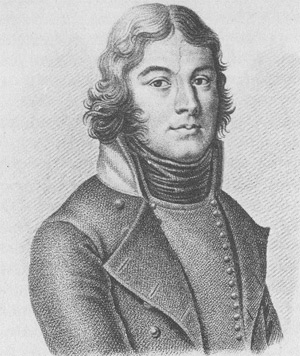
Hoche took his considerable influence as a successful general to the French Directory and convinced them to support the expedition to Ireland. Having gained the necessary political support, Hoche then relied on Minister of Marine Admiral Truguet to ensure the navy could get the army to Ireland. Unfortunately for Hoche, the expedition was to be launched from Brest where Admiral Villaret-Joyeuse was in command. Villaret-Joyeuse did not believe the expedition could be successful and he repeatedly stalled and delayed preparations, costing months of valuable time. After Hoche's repeated complaints to the Minister of Marine, Truguet replaced Villaret-Joyeuse with Admiral Morard de Galles who began the preparations in earnest.
Once preparations were complete, the French fleet set sail from Brest on December 15, 1796 with approximately 15,000 soldiers on a variety of ships of the line, frigates, and transports. Once at sea, the weather did not cooperate and the French ships were scattered by a storm. Rear Admiral Bouvet gathered a number of ships and made his way to the designated rendezvous of Bantry Bay, but the flagship Fraternité, carrying the commander-in-chief General Hoche and Admiral Morard de Galles, was nowhere to be found. General Grouchy, second in command of the army, and Admiral Bouvet, leading the gathered ships, were unsure if they should land the troops without their respective commanders. Serving alongside Grouchy was Hoche's chief of staff, General Chérin. Chérin repeatedly implored Grouchy to disembark the troops, but Grouchy would not do so, and Chérin grew so frustrated that he allegedly contemplated throwing Grouchy overboard to force the matter. Grouchy instead did nothing and waited upon the arrival of Hoche. Grouchy's inaction without orders from above was curiously predictive of his abilities as a commander when years later in 1815 he failed to respond to the Battle of Waterloo. While the French fleet awaited its commanders and took no action, Admiral Bouvet grew anxious due to the weather, the possibility of encountering the British navy, and the lack of drive of the army. Bouvet waited a few days and then ordered the assembled fleet to return to Brest.
Meanwhile, the flagship Fraternité carrying General Hoche and Admiral Morard de Galles had been driven westward by the storm and then chased by a British cruiser, further delaying their arrival at Bantry Bay. Their ship arrived alone at Bantry Bay and after speaking with an Irish fisherman Hoche learned that much of the French fleet had arrived, waited a few days, and then departed for France. Furious, Hoche returned to France, where the Directory absolved him of blame and gave him command of the Army of the Sambre and Meuse. Hoche wrote to Admiral Truguet that he would not abandon the Irish people, but he died in 1797 before ever getting another chance to land in Ireland.
Dutch Expedition of 1797
The Batavian Republic, the Dutch sister republic of the French Republic, attempted the next possible expedition to Ireland. In June of 1797, at the insistence of their French allies, the Dutch prepared a fleet for an expedition to Ireland. Admiral de Winter was placed in charge of the navy and General Daendels in charge of the army. However, the weather again did not cooperate, forcing the fleet to stay in port. After failing to sail out of port for a number of days, the troops were disembarked and the plans for the expedition were abandoned. Despite the troops having been disembarked, that October Admiral de Winter led the Dutch fleet out from Texel in attempt to reach Brest and unite with the French fleet. However, the Dutch were intercepted by a British fleet and defeated at the Battle of Camperdown, costing the Batavian Republic much of its navy.
French Expedition of 1798
Without French intervention, Ireland rose in revolt against British rule in May of 1798. This raised the pressure on the French Directory to land troops in Ireland to support the rebels, but the French government had already expended considerable resources in supporting General Bonaparte's expedition to Egypt which had set sail earlier that month. Therefore, they could not immediately equip and launch a force to support the rebels. The Directory decided to create three forces which would launch in turn when funds, troops, and equipment became available. The first force under General Humbert would be composed of approximately 1000 soldiers and carry extra arms and supplies for the Irish rebels. The second force under General Hardy would number approximately 3000 soldiers, while the main force under General Kilmaine would arrive last and number approximately 6000 soldiers.
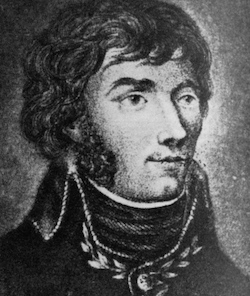
Unfortunately for both the Irish and the French, the Irish rebels scored only a few successes and were mostly defeated in June and finally subdued by July. By this time the French hadn't even launched their first force, but they were unaware of the extent of the defeat of the Irish rebellion. Humbert's initial force set sail from La Rochelle on August 4, 1798 aboard three ships commanded by Daniel Savary. Humbert, originally a rabbit trader before the Revolution, had risen to the rank of general during the early Revolutionary Wars. He also had some past experience with Ireland, having participated in Hoche's 1796 expedition to Ireland and survived the shipwreck of Droits de l'Homme on the return voyage.
Humbert's expedition arrived at Killala on August 22nd, with the ships initially flying British colors to deceive any enemies. After landing the troops, they quickly dispatched the local militia. Humbert immediately issued a proclamation to encourage the Irish people to rise up against British rule, but he also established rules of warfare to enforce that sectarian violence between Catholics and Protestants would not be tolerated. Humbert's proclamation was somewhat ironic coming from French revolutionaries who had rejected the Catholic Church yet were now allies with the oppressed and predominantly Catholic Irish. Nevertheless, Humbert enforced discipline with his seasoned French troops, for in the coming days he was intolerant of looting and even had the most egregious Irish offenders shot by firing squad.
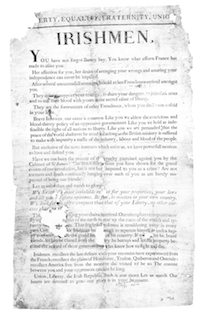
Humbert promoted one of his leading officers, Colonel Sarrazin, to général de brigade for taking Killala and then the next day Humbert sent Sarrazin to the south to ensure the enemy could not counterattack their landing. Sarrazin hurried south to Ballina where he surprised and drove out the British forces that had come up upon first learning of the French landing. Afterwards, Sarrazin and his men returned to Killala.
Humbert's landing immediately drew a few thousand Irish patriots into his force, but facing them was a much more daunting foe. About 150,000 British troops were spread throughout the entirety of Ireland, commanded by Lord Cornwallis. Lord Cornwallis, famous in American history for his surrender to the Americans and French at the Siege of Yorktown in 1781, was a distinguished and respected leader. He had been appointed the British military and civilian commander in Ireland only a month before in an effort to curb the excesses of violence brought about by the Irish uprising. He was also tasked with investigating and reforming the underlying causes of the rebellion. As soon as Cornwallis learned of the French landing, he began concentrating his forces with the goal of cornering and defeating the French forces. However, he could not bring the entirety of his soldiers to bear on the French for fear of Irish uprisings and the need to maintain garrisons throughout the land.
Meanwhile on August 24th Humbert led his main force south to Ballina, intent on taking the strategic crossroads of Castlebar. At Ballina they encountered a force of British troops under Major Kerr holding a defensive position. Sarrazin led a frontal attack with French troops while another French detachment moved to turn the British flank. The British began to withdraw to avoid being surrounded, but then Humbert charged with cavalry and the British withdrawal turned into a rout.
Battle of Castlebar
On August 26th Humbert and his men left Ballina, marching for Castlebar south along the Foxford road. However, in an attempt to surprise the British, once darkness fell they turned and took the less traversable road to Crossmolina. Meanwhile, a large number of British troops had been ordered to Castlebar to throw the French out of Ireland, and on the 26th they numbered about 6000 men. General Lake, known for his brutality during the Irish rebellion only a few months before, had been sent to Castlebar by Cornwallis to take overall command of the area. Once Lake learned of the small size of Humbert's force, he disdainfully disregarded maps of the area and confidently assumed that the French would be crushed as soon they arrived at Castlebar. Unfortunately for the French, a civilian loyal to Great Britain had spotted the French movement early in the morning on the 27th and warned the British at Castlebar. While this report was initially disbelieved, once it was confirmed the British were temporarily thrown into confusion as they were quickly forced to alter their defensive positions to receive an attack from the north instead of the east.
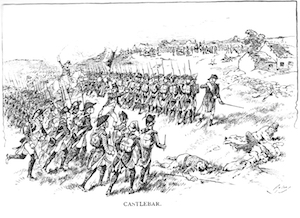
Around eight in the morning of the 27th, Humbert and his force came within sight of Castlebar and realized that their surprise had failed when they saw the British formed in defensive positions against them. Nevertheless, Humbert resolved to attack despite his much smaller force. Humbert first sent forward the Irish volunteers and right behind them he placed the French grenadiers under Sarrazin. The Irish successfully drove back the British outposts and then rushed towards the British line. The British line patiently waited until the attackers were in close range and then opened fire with a single devastating volley, scattering and destroying the momentum of the charge. The Irish volunteers who survived this volley fled from the scene while the French grenadiers took cover behind a nearby house.
However, after that initial volley, the British began firing sporadically and without unison, and Humbert recognized that they were not coordinated well. In response he formed his remaining troops in a long, thin line and ordered a bayonet charge. As the French approached, Sarrazin ordered the remaining grenadiers to charge and the French successfully took the British artillery position. Seeing the loss of his artillery position, General Lake ordered his men to fall back, but by now the British lost all cohesion. The impact of the bayonet charge overwhelmed the British and various units broke and fled. In their haste to escape the bayonet, the British soldiers crowded into the town of Castlebar where a bottleneck formed at the main bridge across the river. As the French pursued, British soldiers were killed in the panic to cross the bridge, but a few British units maintained their composure and formed a rearguard to hold the bridge. The French took cover in the buildings and fired into the rearguard before eventually charging and sweeping the British from the town. Despite the odds, Humbert had won the Battle of Castlebar, which became known as the "Races of Castlebar" due to the speed of the British retreat.
Now in control of Castlebar, Humbert worked with the Irish for the next few days to establish the Republic of Connacht as the new government of Ireland. However, he was well aware of the the numerical inferiority of his troops against the British stationed throughout Ireland and he knew that the British would be returning to Castlebar soon. Humbert wished to seize Dublin to inspire the Irish people, but he also needed to avoid pitched battles to buy more time. With enough time, the second French force under General Hardy would land in Ireland and more of the Irish people would rise up. Learning of a sizeable British force gathered to the southeast at Athlone and blocking his route to Dublin, Humbert decided to abandon Castlebar and head northeast to Sligo. On the night of September 3rd, he and his force abandoned Castlebar and released their British prisoners, one of whom promptly went to the British army and informed them of the French departure.
The Trap Closes
Humbert's force marched towards Sligo via Swinford and then Tobercurry. They marched unopposed until September 5th when the French arrived at the town of Collooney less than ten miles south of Sligo. Colonel Vereker commanding the 600 British troops garrisoned at Sligo had brought his troops south to Collooney to try and stop the French. On the north side of Collooney, the two opposing forces formed in lines and prepared for battle. Vereker attacked first despite having less troops and for a time the British held their own until the French began to flank them. Vereker then ordered a retreat and the British began an orderly withdrawal while Humbert did not pursue. As it turned out, both commanders believed they had repulsed the enemy's advance guard and a stronger force was just behind. Therefore, Vereker fell back towards Sligo while Humbert turned east to avoid a larger confrontation.
In the meantime, a large contingent of British troops commanded by the vengeful General Lake continued to pursue Humbert, intent on bringing him to battle and crushing his small force. Humbert abandoned his artillery to speed his march and the British arrived at Collooney only hours after the French and Irish had departed. Humbert's force made their way to Manor Hamilton where he learned that an Irish force of rebels was concentrated at Granard. Aware that the British were now behind him and no longer blocking the road to Dublin, he hoped to join with the Irish force at Granard and race to Dublin to spur the Irish uprising. Humbert turned south and marched to Drumshanbo and then east to Ballinamore. Between these two towns the French rearguard repulsed the British cavalry's pursuit, inflicting some losses. Next Humbert turned south and made his way to Cloone where his men arrived at nightfall on September 7th. An Irishman arrived and informed Humbert that the Irish he had hoped to join with at Granard had been defeated, but the Irish messenger also claimed that groups of Irish rebels remained scattered in the area. Humbert's force snatched a few hours of sleep and then left Cloone the next morning at the same time as the as the British began to arrive on the other side of town.
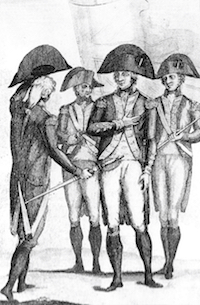
Humbert hurriedly marched south, still intent on reaching Granard and then Dublin, but the British pursuit continually harassed his rearguard. Lord Cornwallis had guessed Humbert's strategy of rushing to Dublin and the British commander moved his main force of 20,000 men to block the path. He also ordered General Lake's forces pursuing the French to attack at once, trying to drive them into his trap. Finally, Humbert accepted that his men could not outrun their pursuers and he ordered his army to stop at Ballinamuck and form up for battle. Aware that he was being surrounded and they could not win against the superior numbers of the British, Humbert nonetheless ordered his army into a defensive position on a hill. To preserve French honor, he refused to surrender without first giving the British a bit of a fight. General Sarrazin, in command of the French rear guard, almost immediately surrendered. After some initial maneuvers to get into position, the British assaulted the French line with infantry and dragoons and Humbert surrendered. However, the Irish contingent of his army expected little mercy and refused to surrender, nor were they offered the opportunity to surrender. While the French stood by having surrendered, the British army relentlessly assaulted and chased the Irish rebels, slaughtering all they could. The few Irish rebels who did surrender were later executed.
Contrary to the brutal treatment towards the Irish rebels, the French of Humbert's force were well treated by the British as prisoners of wars. In particular, the British admired that the French had restrained their Irish contingent from sectarian reprisals and looting. However, French officers of Irish birth, such as Humbert's aide-de-camp Bartholomew Teeling and Matthew Tone, brother of Irish patriot Wolfe Tone, were separated from the French and identified as traitors. Teeling in particular had served throughout the Revolutionary Wars in France and risen through the ranks on his own merit. Humbert informed the British that these officers were members of the French military and insisted that they be treated as French, and Humbert initially accompanied Teeling to prison and refused to leave his side. Humbert was then separated from his aide and he wrote a letter for clemency for his Irish-born French officers, but in the end his aide Teeling and the others were executed. These officers went to their execution dressed in their French uniforms, and the French people were incensed upon learning of the fate of these prisoners of war. The writer Thomas Paine wrote a letter to the French Directory arguing for retaliation against British prisoners of war held by the French, but the Directory declined to take such measures.
While Humbert's main force had been defeated, he had committed a few French officers to command the Irish rebels at Ballina and Killala. On September 22nd a large number of British troops approached Ballina and the French and Irish there withdrew to Killala. The French officers considered it their duty to lead the Irish rebels despite the odds against them, and on the 23rd the British attacked Killala and defeated the last of the rebel forces.
Back in France, preparations had continued for the second force under General Hardy to be landed in Ireland by a fleet commanded by Admiral Bompart. This force set sail from Brest on September 17th, unaware that Humbert had surrendered on September 8th. Hardy, Bompart, and the Irish patriot and leader Wolfe Tone were aboard the French flagship named Hoche in honor of the deceased general. The French fleet was spotted enroute to Ireland and pursued by a few British ships, but eventually the French believed they had evaded and lost their pursuers. However, the British were still hunting for the French fleet, and on October 11th a British fleet under Sir John Borlase Warren spotted the French and gave chase. The next day Admiral Bompart ordered his fleet to turn and engage in battle, and over the course of a few hours the French fleet was defeated in what became known as the Battle of Lough Swilly. Some of the French ships, including Hoche, were captured while some ships managed to escape. The commanders Bompart, Hardy, and Tone were all taken prisoner, and as a leader of the Irish rebellion Wolfe Tone was tried and sentenced to execution. When his request to be executed by firing squad was denied, Tone committed suicide in prison before his execution could be carried out.
Aftermath
After the failure of the expedition to Ireland of 1798, the French government made no more attempts to help liberate Ireland from British rule. As for the principal French participants during the expeditions to Ireland, Hoche, Humbert, and Sarrazin all left their unique marks on history.
In 1797 General Hoche and the Army of the Sambre and Meuse traveled to Paris and met up with a contingent of General Bonaparte's Army of Italy commanded by General Augereau. Concerned about the recent surge in power of royalists in the government, both Hoche and Bonaparte sent their troops to support the the republicans in power and the Directory. With these generals backing them, the Directory succeeded in ousting and exiling the royalists from France. This coup became known as the coup of 18 Fructidor, but only two weeks later Hoche died under mysterious circumstances, having made a fair number of enemies in both royalist and republican circles.
General Humbert took part in the French expedition to retake Saint-Domingue in 1802, but he was sent back to France before long. Rumors swirled that Pauline Bonaparte and Humbert had formed an intimate relationship, but this was never proven. Given Napoleon's eye for talent, it is suspicious that Humbert was never employed in Napoleon's empire. Humbert eventually traveled to the United States where he took part in the Battle of New Orleans in 1815, helping the Americans repulse the British attack on that city during the inaptly named War of 1812.
Humbert's subordinate Sarrazin had his 1798 promotion from Humbert nullified by the Directory, but Sarrazin was later promoted to général de brigade in 1799. Much like Sarrazin's friend General Bernadotte, Sarrazin intrigued against the French Empire, though Sarrazin never rose as high as Bernadotte. While Bernadotte eventually became Crown Prince of Sweden and led Swedish troops against the French Empire in 1813, Sarrazin's treachery was much less notable. Sarrazin was sent to Boulogne in 1809 and the next year he defected to the British, taking some intelligence but little else. Sarrazin returned to France after the Bourbon Restoration of 1814 and he was later tried and convicted of bigamy.
In conclusion, each French expedition failed to achieve the goal of liberating Ireland, but their failures were due more to poor timing and weather than the superiority of the British navy. Humbert's expedition in 1798 successfully landed French troops in Ireland, becoming the only enemy force to land troops on the British Isles in modern history. Against all odds, Humbert led his small force halfway across Ireland before being surrounded and defeated by superior British numbers. Had the French Directory acted sooner and in conjunction with the Irish uprising in May of 1798, events may have turned out very differently. In the years following the Irish uprising, Lord Cornwallis led reforms to alleviate some of the underlying causes of the Irish rebellion of 1798, but the Irish would spend another century striving for independence.
Bibliography
- Baines, Edward. History of the Wars of the French Revolution. London: Forgotten Books, 2012.
- Chandler, David G. Dictionary of the Napoleonic Wars. New York: Macmillan Publishing Co., Inc., 1979.
- Deléry, Simone de la Souchère. Napoleon's Soldiers in America. Gretna: Pelican Publishing Company, 1950.
- Gribayedoff, Valerian. The French Invasion of Ireland in '98. Whitefish: Kessinger Legacy Reprints, 2010.
- Griffiths, Arthur George Frederick. French Revolutionary Generals. London: Forgotten Books, 2012.
- Haythornthwaite, Philip J. Who Was Who in the Napoleonic Wars. London: Arms & Armour, 1998.
- Pakenham, Thomas. The Year of Liberty: The Great Irish Rebellion of 1798. New York: Random House, 1998.
- Six, Georges. Dictionnaire Biographique des Généraux & Amiraux Français de la Révolution et de l'Empire (1792-1814). 2 vols. Paris: Gaston Saffroy, 2003.
- Williams, James. The Naval History of Great Britain. London: Harding, Lepard and Co, 1826.
Related Pages:
Updated January 2023
© Nathan D. Jensen